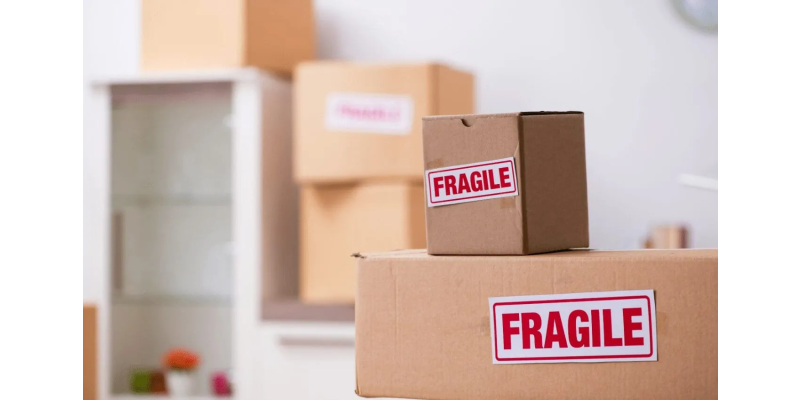If you ship fragile items, choosing the right shipping supplies isn't just a logistics task; it's a direct investment in your customer satisfaction and brand reputation. According to Contimod, 10% of e-commerce packages arrive damaged, and a staggering 58% of consumers won't reorder after receiving a broken product. With those odds, proper packaging isn't optional, it's essential.
It doesn't matter if you're shipping handmade ceramics, electronics, or glassware, damage can happen anywhere between your facility and your customer's door. From improper cushioning to a box that's too large or weak, small mistakes have big consequences. Fortunately, using the right fragile shipping supplies can reduce the risk significantly.
Let's walk through a clear, step-by-step process to help you ship fragile items safely and confidently.
Step 1: Select the Right Box
Corrugated Box Wall Strength
Your first line of defense is the outer box. Most fragile items require a double-walled corrugated box. Single-wall boxes might suffice for lightweight, non-breakable items, but fragile goods need more protection.
- Single-wall: Light protection for non-fragile or low-value items
- Double-wall: Ideal for fragile or heavier items
- Triple-wall: Necessary for industrial-grade or high-value fragile goods
Box Sizing Guidelines
Follow the 2–3 inch rule: There should be 2 to 3 inches of space between the item and the box walls for cushioning.
A box that's too big increases the need for void fill, while one that's too tight risks impact damage. Choosing the right size helps you cut costs and protect better.
Standard vs Custom Boxes
Standard boxes are easy to source and cost-effective, but custom boxes tailored to your product's shape can improve safety and reduce shipping volume. For high-value or unusually shaped items, custom sizing is often worth the investment.
Step 2: Choose Primary Cushioning
Bubble Roll Types & Best Practices
Bubble roll is a staple for fragile shipping supplies. But not all bubble rolls or bubble paper sheets are the same:
- Small bubbles: Better for light, delicate items (like glassware)
- Large bubbles: Better for heavier, larger items (like electronics)
- Anti-static bubble: Best for electronics
Wrap items with at least two inches of bubble paper sheet, secure with tape, and make sure there are no exposed surfaces.
Tip: Always wrap items individually to prevent them from bumping against each other inside the box.
Polyethylene Foam & Foam-in-Place Options
Polyethylene foam is a great alternative to bubble paper sheets for items needing soft yet durable support. It cushions without collapsing under weight. Ideal for electronics, machinery parts, and tools.
Foam-in-place systems mold foam around the product, offering unmatched precision. Use it when you ship irregularly shaped or high-value items.
Example: Medical device companies frequently use foam-in-place for delicate surgical tools due to the reliable form-fit protection.
Custom Foam Inserts
For repeated shipments of the same item, custom foam inserts provide consistent protection and speed up your packing process. They're made to fit the item and box exactly, reducing the risk of movement and damage.
Step 3: Fill Voids Effectively with Dunnage
Air Pillows vs Packing Peanuts vs Kraft Paper
Dunnage fills empty space in the box and absorbs shock. Choosing the right type depends on the product and your sustainability goals.
|
Material |
Cost |
Protection |
Eco-Friendly |
|
Air Pillows |
$$ |
Medium |
Partially |
|
Packing Peanuts |
$ |
Medium-High |
Yes (if biodegradable) |
|
Kraft Paper |
$$ |
High |
Yes |
Biodegradable peanuts made from cornstarch offer strong protection and compostability. Kraft paper is easy to recycle and effective for heavy or dense items.
Ensuring a Snug Fit & Movement Test
Once cushioned and filled, close the box and gently shake it. If the item moves, add more dunnage. The goal is a snug, secure fit with no internal shifting.
Tip: For high-value shipments, consider adding box-in-box packaging, where the product is packed in a small box that's then suspended in a larger box with padding around all sides.
Step 4: Secure and Seal Your Package
H-Tape Method for Sealing
Use the H-tape sealing method to ensure the box remains closed and strong during transit:
- Apply tape down the center seam
- Add strips across both edge flaps (forming an "H")
Use strong shipping tape (at least 2" wide) and avoid masking or duct tape.
Fragile Handling Labels & Orientation Labels
Add clear fragile handling labels and orientation labels ("This Side Up") to communicate handling needs to carriers. While these don't guarantee gentle handling, they help reduce rough treatment when paired with internal protection.
Pro Tip: Use labels on all sides of the box to ensure visibility regardless of how the package is handled.
Step 5: Test and Refine Your Packaging
Drop Tests & Impact Sensors
Before shipping at scale, test your packaging by conducting a drop test from various angles and heights (typically 30-36 inches). Consider adding impact sensors to sensitive shipments to measure transit shock.
Note: Document the test process and results. This data helps justify packaging costs and improvements.
Trial Shipments & Iterative Improvements
Send a few trial shipments to team members or trusted customers to gather feedback. Adjust box size, cushioning, or labeling based on what you learn.
Carrier Packing Services Comparison
FedEx Office Packing Pledge
With the FedEx Office Packing Pledge, FedEx assumes liability for your item's safety if they pack it. This option is great for valuable or one-off fragile items where you need peace of mind.
The UPS Store Pack & Ship Guarantee
Like FedEx, the UPS Pack & Ship Guarantee transfers damage liability to UPS when its employees pack the item using approved supplies.
|
Carrier |
Service |
Liability Covered |
Turnaround Time |
Best For |
|
FedEx |
Office Packing Pledge |
Yes |
Fast |
Art, tech, glass items |
|
UPS |
Pack & Ship Guarantee |
Yes |
Fast |
Electronics, antiques |
|
USPS |
Special Handling (Fragile) |
No liability coverage |
Standard |
Small items under $50 |
USPS Special Handling (Fragile)
USPS offers Special Handling – Fragile, which flags your shipment for extra care. However, this service doesn't include insurance, so use it in conjunction with USPS insurance and proper packaging.
Sustainable Packaging for Fragile Items
Recycled Corrugated & Kraft Paper
Choosing recycled corrugated boxes and kraft paper supports eco-friendly shipping without compromising durability.
Biodegradable Peanuts & Mushroom Packaging
Biodegradable peanuts break down easily and offer strong cushioning. Mushroom packaging (mycelium-based) is another option that is gaining popularity for its strength and compostability.
Recyclability and Composability Considerations
When selecting packaging, check if the materials are:
- Curbside recyclable (corrugated, kraft)
- Compostable (biodegradable peanuts, mushroom packaging)
- Recycled-content certified
FAQs
1. What is the best packaging for fragile items?
Use a multi-layered system:
- Primary cushioning: 2–3" of bubble paper sheet or polyethylene foam
- Outer box: Double-walled corrugated box with 2–3" of space
- Void fill: Air pillows, packing peanuts, or kraft paper
- Sealing: H-tape method
- Labeling: Fragile and orientation labels
- Optional: Box-in-box method for very high-value items
2. What is the best shipping service for fragile items?
- FedEx Office Packing Pledge or UPS Pack & Ship Guarantee for the highest liability coverage
- For DIY packing, FedEx and UPS offer strong tracking and insurance.
- USPS Priority is cost-effective for small items when combined with insurance
3. Is UPS or FedEx better for shipping fragile items?
They are comparable in service and reliability. Choose based on proximity, shipping rates, or value-added services. Both offer professional packing services that transfer liability.
4. What is the best transport for fragile items?
- Air freight: Fastest and minimal handling
- Specialized ground (white glove): Ideal for art or heavy equipment
- Standard ground (UPS/FedEx/USPS): Most cost-effective for well-packaged items
5. How do I ship fragile items internationally?
Use double-boxing and ample cushioning, and verify that your carrier offers international insurance. Be aware of customs restrictions for specific materials.
6. Can I reuse boxes or materials?
Only reuse boxes that are undamaged and structurally sound. Avoid reusing bubble paper sheets or peanuts that are flattened or dusty. Sustainable packaging doesn't have to mean reused if integrity is compromised.
7. What's the best way to store fragile shipping supplies?
Store items like bubble roll, kraft paper, and boxes in a dry, climate-controlled area. Keep foam materials away from direct sunlight to prevent degradation.
Next Steps
Shipping fragile items safely is more than just wrapping them up and hoping for the best. With the right fragile shipping supplies, careful box sizing, proper cushioning, snug void fill, secure sealing, and smart labeling, you drastically reduce the risk of damage. Add to that sustainable practices and reliable carrier partnerships, and you're not just protecting products—you're protecting your brand.
Next time you prep a fragile shipment, treat each step as an opportunity to improve. Test your process, compare your materials, and don't hesitate to get a Custom Bulk eQuote if you ship in volume. It can save you money and provide the best-fit supplies for your needs.
For reliable, high-quality boxes, cushioning, and eco-friendly options, StarBoxes has you covered.
Ready to upgrade your fragile item shipping process? Contact StarBoxes for expert support and competitive pricing on bulk packaging solutions.







